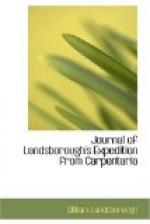We saw large quantities of the small white cockatoos, and the rose-coloured ones, which are to be found only in the inland settled country of New South Wales and Queensland. The Albert River being navigable will make the country on its banks very valuable, as I believe sheep will do well on it, more especially as they do well on inferior-looking country within the tropics to the north-west of Rockhampton.
Allow me to recommend for the depot which you propose forming with the Firefly hulk on the Albert River some place as convenient as possible to Woods Lake, or the waterhole that I mentioned that I had found near the head of the navigation, and as there is very little forage on board the Firefly it would be advisable to land, as soon as possible, the horses on the west bank of the river above the second inlet, that is, if there is any chance of the Firefly being delayed in proceeding up the river.
I have the honour to be, etc.,
(Signed) W. Landsborough,
Commander of the Victorian and Queensland Land Expedition.
...
(Number 3.)
Brisbane party, W. Landsborough, esquire, leader.
Continuation of report on the Albert river, etc.
October 15th 1861.
(Copy.)
Albert River, Gulf of Carpentaria, October 15 1861.
To Captain Norman of H.M.C.S. Victoria, and Commander-in-chief
of the
Northern Expedition Parties.
Sir,
I have the honour to inform you that the senior lieutenant of H.M.C.S. Victoria, having been commissioned by you to take the Firefly hulk to the head of the navigation of the Albert River to form a depot there, shortly after midnight of the 14th October, at the flood of the tide, which occurs here only once in twenty-four hours, we stood in for the mouth of the river and, as the channel is of a winding character, and the ship almost unmanageable, we had to take her right over the bar. From thence we proceeded some time after daylight with a fair wind, several miles up the river to where we took grass on board, which some of my party, having preceded us, had in readiness. On the 16th, from the time of the tide, the wind being unfavourable, we had reached no further than Norman’s Group of Islands, which are about ten miles in a straight line from the mouth of the river. At that place, from the small quantity of water on board it became necessary to decide on what bank the horses should be landed; consequently three parties started in search of water—a boat and two land parties. The former, under the command of Mr. Frost, found a good pond of water near the lowest water we had found when we first explored the Albert River. In the same neighbourhood Mr. Campbell’s party, who went up the west bank of the river, found another waterhole, which was distant from the ship, by the road they went, about four miles, and passable for the horses, although partly over mudflats which during high tides are covered with water; and on that account I thought, having observed the country to be very low from the masthead, it would be impassable.




